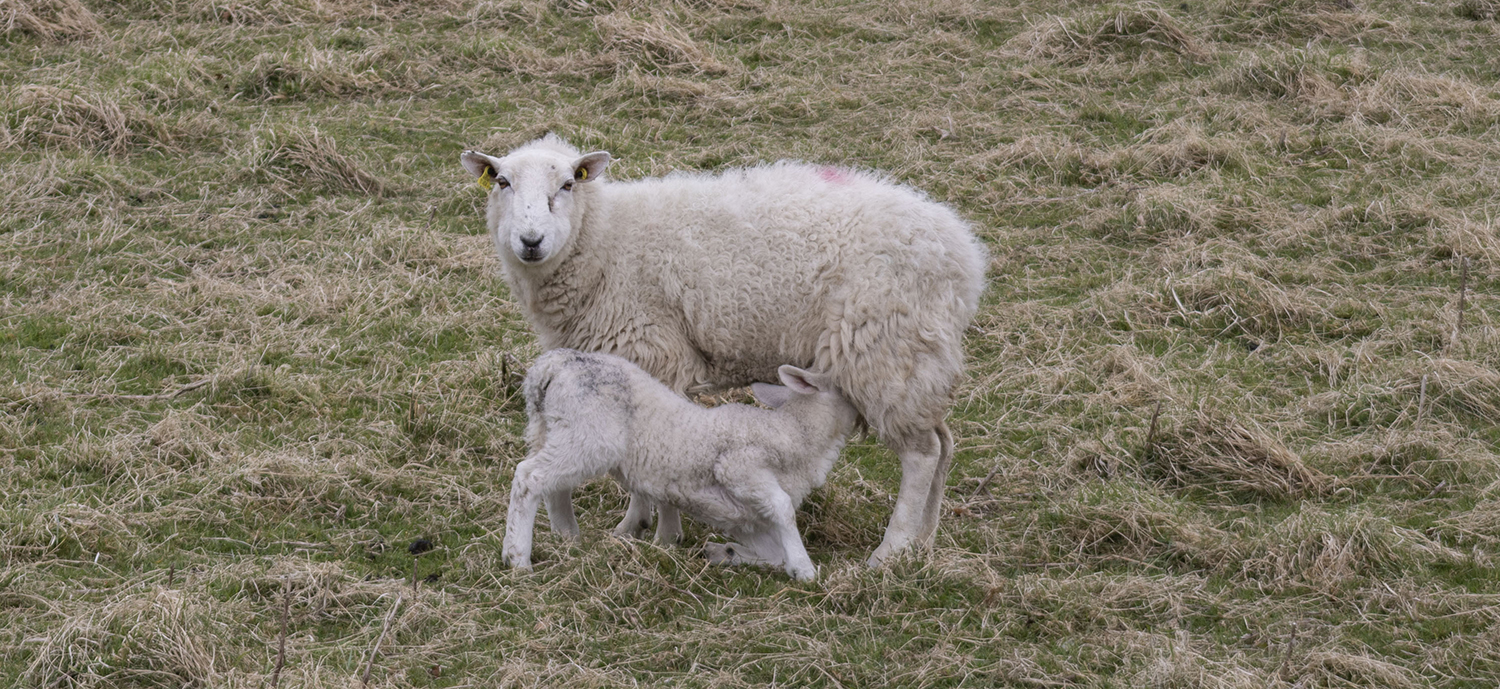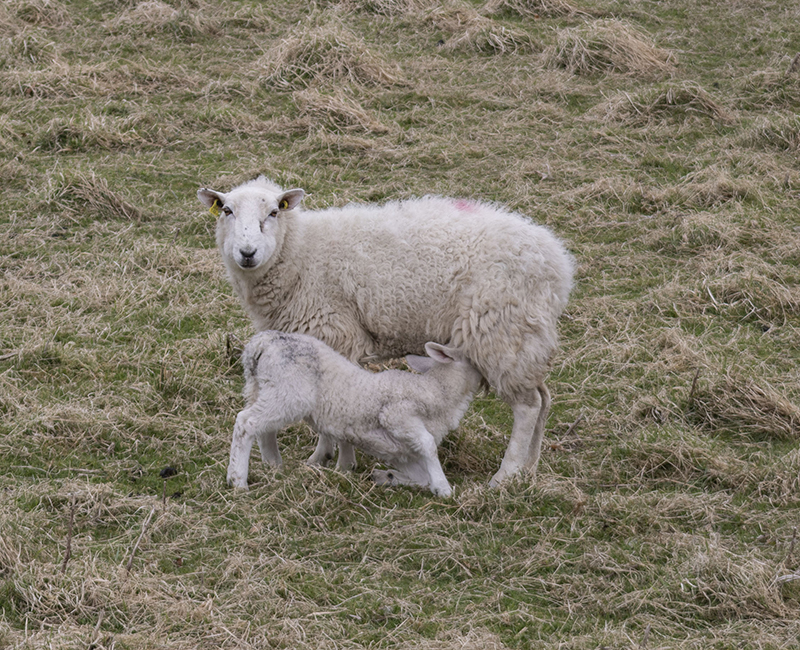





Anyone raising livestock knows the importance of early immunity. The neonate is born with immature immunity, which if not addressed can lead to loss of that animal - and it happens quickly. Over half of UK lamb mortality is said to occur in the first 24 hours of life, and mortality rates of nearly 4% are seen in calves up to the age of three months. However, of course, it’s not just about mortality. Those with a poor start in life can show reduced daily liveweight gain, poorer feed conversion efficiency and a longer rearing period throughout their life. Getting a good start could not be more important.
For all mammals, early suckling will provide the neonate with colostrum, that essential ‘first milk’ fortified with antibodies to provide immunity, essential nutrients and energy for growth. However, how do we know that our lambs or calves have received enough from mum, and that what she is producing is of sufficient quality? The simple answer is, we don’t. Colostrum quality cannot be assessed by eye. Unless the newborn is suckling well, on healthy teats, from a mum who is producing sufficient levels of good quality colostrum then the compromised immunity that they are born with may become a lifelong issue. By the time that is recognized, it could well be too late, as there is only a small window of opportunity to get those essential antibodies (IgG) across the gut barrier and into their immune system.
For all mammals, early suckling will provide the neonate with colostrum, that essential ‘first milk’ fortified with antibodies to provide immunity, essential nutrients and energy for growth. However, how do we know that our lambs or calves have received enough from mum, and that what she is producing is of sufficient quality? The simple answer is, we don’t. Colostrum quality cannot be assessed by eye. Unless the newborn is suckling well, on healthy teats, from a mum who is producing sufficient levels of good quality colostrum then the compromised immunity that they are born with may become a lifelong issue. By the time that is recognized, it could well be too late, as there is only a small window of opportunity to get those essential antibodies (IgG) across the gut barrier and into their immune system.
The 3 Qs of Colostrum
Quality
A good quality colostrum is not just about immunity, but supports growth, development of the gastrointestinal system, reduces susceptibility to infection from E.coli or Salmonella, and in so doing can reduce the use of antibiotics on farm. Conversely, a poor quality colostrum simply wastes money, and, unfortunately, there are plenty out there.
A recent independent study, published in the Veterinary Record, reported that over 73% of commercial colostrums tested failed to reach the required rate of 3g IgG / feed for lambs. Great variability of IgG levels in the market were demonstrated, with results showing levels as low as less than 1g IgG in several commercial products, clearly well below the required.
Here at Greencoat Farm we are proud to stand behind the results of that study – which we were in no way involved with – and which clearly showed that the quality of our formulae speaks for itself.
Quantity
Giving a colostrum product also ensures that sufficient quantity has been taken in, which we can never be 100% sure of when suckling from mum. For the first feed, we must safeguard that a minimum of 100ml colostrum is fed to lambs, and two litres to calves, in the first six hours. If feeding a good quality colostrum only one feed should be needed, but a second can be given if any challenges with the dam or newborn are recognized.
Quickly
Time is of the essence, so waiting to see whether mum is producing sufficient colostrum is a risky strategy. Efficacy of antibody absorption, including that of the important IgG, declines rapidly after birth. Ideally ensure colostrum is fed within two to three hours, but certainly within six hours. If a further colostrum feed is required, ensure it is given within twenty-four hours

Conculsion
In conclusion we can see that it isn’t worth taking risks with young livestock lives, as it represents a danger both to the animal and to your business. Feed Quality colostrum, in the right Quantity and Quickly to all newborns, to maximize health and potential.
References
About the Author
Kate Hore is a Registered Nutritionist with the Association for Nutrition, and a Registered Animal Technologist with the British Society of Animal Science. Experienced in targeted nutrition, Kate has worked as Head Nutritionist at Greencoat for nearly 25 years.
Animal nutrition runs in the family, as Kate’s father was an eminent ruminant nutritionist, whilst Kate works in livestock, equine and pet nutrition.
When not working, Kate enjoys getting out around her home in The Lakes, and particularly appreciates seeing the native Herdwicks out on the fells.
Anyone raising livestock knows the importance of early immunity. The neonate is born with immature immunity, which if not addressed can lead to loss of that animal - and it happens quickly. Over half of UK lamb mortality is said to occur in the first 24 hours of life, and mortality rates of nearly 4% are seen in calves up to the age of three months. However, of course, it’s not just about mortality. Those with a poor start in life can show reduced daily liveweight gain, poorer feed conversion efficiency and a longer rearing period throughout their life. Getting a good start could not be more important.
For all mammals, early suckling will provide the neonate with colostrum, that essential ‘first milk’ fortified with antibodies to provide immunity, essential nutrients and energy for growth. However, how do we know that our lambs or calves have received enough from mum, and that what she is producing is of sufficient quality? The simple answer is, we don’t. Colostrum quality cannot be assessed by eye. Unless the newborn is suckling well, on healthy teats, from a mum who is producing sufficient levels of good quality colostrum then the compromised immunity that they are born with may become a lifelong issue. By the time that is recognized, it could well be too late, as there is only a small window of opportunity to get those essential antibodies (IgG) across the gut barrier and into their immune system.
For all mammals, early suckling will provide the neonate with colostrum, that essential ‘first milk’ fortified with antibodies to provide immunity, essential nutrients and energy for growth. However, how do we know that our lambs or calves have received enough from mum, and that what she is producing is of sufficient quality? The simple answer is, we don’t. Colostrum quality cannot be assessed by eye. Unless the newborn is suckling well, on healthy teats, from a mum who is producing sufficient levels of good quality colostrum then the compromised immunity that they are born with may become a lifelong issue. By the time that is recognized, it could well be too late, as there is only a small window of opportunity to get those essential antibodies (IgG) across the gut barrier and into their immune system.
The 3 Qs of Colostrum
Quality
A good quality colostrum is not just about immunity, but supports growth, development of the gastrointestinal system, reduces susceptibility to infection from E.coli or Salmonella, and in so doing can reduce the use of antibiotics on farm. Conversely, a poor quality colostrum simply wastes money, and, unfortunately, there are plenty out there.
A recent independent study, published in the Veterinary Record, reported that over 73% of commercial colostrums tested failed to reach the required rate of 3g IgG / feed for lambs. Great variability of IgG levels in the market were demonstrated, with results showing levels as low as less than 1g IgG in several commercial products, clearly well below the required.
Here at Greencoat Farm we are proud to stand behind the results of that study – which we were in no way involved with – and which clearly showed that the quality of our formulae speaks for itself.
Quantity
Giving a colostrum product also ensures that sufficient quantity has been taken in, which we can never be 100% sure of when suckling from mum. For the first feed, we must safeguard that a minimum of 100ml colostrum is fed to lambs, and two litres to calves, in the first six hours. If feeding a good quality colostrum only one feed should be needed, but a second can be given if any challenges with the dam or newborn are recognized.
Quickly
Time is of the essence, so waiting to see whether mum is producing sufficient colostrum is a risky strategy. Efficacy of antibody absorption, including that of the important IgG, declines rapidly after birth. Ideally ensure colostrum is fed within two to three hours, but certainly within six hours. If a further colostrum feed is required, ensure it is given within twenty-four hours

Conculsion
In conclusion we can see that it isn’t worth taking risks with young livestock lives, as it represents a danger both to the animal and to your business. Feed Quality colostrum, in the right Quantity and Quickly to all newborns, to maximize health and potential.
References
About the Author
Kate Hore is a Registered Nutritionist with the Association for Nutrition, and a Registered Animal Technologist with the British Society of Animal Science. Experienced in targeted nutrition, Kate has worked as Head Nutritionist at Greencoat for nearly 25 years.
Animal nutrition runs in the family, as Kate’s father was an eminent ruminant nutritionist, whilst Kate works in livestock, equine and pet nutrition.
When not working, Kate enjoys getting out around her home in The Lakes, and particularly appreciates seeing the native Herdwicks out on the fells.
Anyone raising livestock knows the importance of early immunity. The neonate is born with immature immunity, which if not addressed can lead to loss of that animal - and it happens quickly. Over half of UK lamb mortality is said to occur in the first 24 hours of life, and mortality rates of nearly 4% are seen in calves up to the age of three months. However, of course, it’s not just about mortality. Those with a poor start in life can show reduced daily liveweight gain, poorer feed conversion efficiency and a longer rearing period throughout their life. Getting a good start could not be more important.
For all mammals, early suckling will provide the neonate with colostrum, that essential ‘first milk’ fortified with antibodies to provide immunity, essential nutrients and energy for growth. However, how do we know that our lambs or calves have received enough from mum, and that what she is producing is of sufficient quality? The simple answer is, we don’t. Colostrum quality cannot be assessed by eye. Unless the newborn is suckling well, on healthy teats, from a mum who is producing sufficient levels of good quality colostrum then the compromised immunity that they are born with may become a lifelong issue. By the time that is recognized, it could well be too late, as there is only a small window of opportunity to get those essential antibodies (IgG) across the gut barrier and into their immune system.
For all mammals, early suckling will provide the neonate with colostrum, that essential ‘first milk’ fortified with antibodies to provide immunity, essential nutrients and energy for growth. However, how do we know that our lambs or calves have received enough from mum, and that what she is producing is of sufficient quality? The simple answer is, we don’t. Colostrum quality cannot be assessed by eye. Unless the newborn is suckling well, on healthy teats, from a mum who is producing sufficient levels of good quality colostrum then the compromised immunity that they are born with may become a lifelong issue. By the time that is recognized, it could well be too late, as there is only a small window of opportunity to get those essential antibodies (IgG) across the gut barrier and into their immune system.
The 3 Qs of Colostrum
Quality
A good quality colostrum is not just about immunity, but supports growth, development of the gastrointestinal system, reduces susceptibility to infection from E.coli or Salmonella, and in so doing can reduce the use of antibiotics on farm. Conversely, a poor quality colostrum simply wastes money, and, unfortunately, there are plenty out there.
A recent independent study, published in the Veterinary Record, reported that over 73% of commercial colostrums tested failed to reach the required rate of 3g IgG / feed for lambs. Great variability of IgG levels in the market were demonstrated, with results showing levels as low as less than 1g IgG in several commercial products, clearly well below the required.
Here at Greencoat Farm we are proud to stand behind the results of that study – which we were in no way involved with – and which clearly showed that the quality of our formulae speaks for itself.
Quantity
Giving a colostrum product also ensures that sufficient quantity has been taken in, which we can never be 100% sure of when suckling from mum. For the first feed, we must safeguard that a minimum of 100ml colostrum is fed to lambs, and two litres to calves, in the first six hours. If feeding a good quality colostrum only one feed should be needed, but a second can be given if any challenges with the dam or newborn are recognized.
Quickly
Time is of the essence, so waiting to see whether mum is producing sufficient colostrum is a risky strategy. Efficacy of antibody absorption, including that of the important IgG, declines rapidly after birth. Ideally ensure colostrum is fed within two to three hours, but certainly within six hours. If a further colostrum feed is required, ensure it is given within twenty-four hours

Conculsion
In conclusion we can see that it isn’t worth taking risks with young livestock lives, as it represents a danger both to the animal and to your business. Feed Quality colostrum, in the right Quantity and Quickly to all newborns, to maximize health and potential.
References
About the Author
Kate Hore is a Registered Nutritionist with the Association for Nutrition, and a Registered Animal Technologist with the British Society of Animal Science. Experienced in targeted nutrition, Kate has worked as Head Nutritionist at Greencoat for nearly 25 years.
Animal nutrition runs in the family, as Kate’s father was an eminent ruminant nutritionist, whilst Kate works in livestock, equine and pet nutrition.
When not working, Kate enjoys getting out around her home in The Lakes, and particularly appreciates seeing the native Herdwicks out on the fells.
